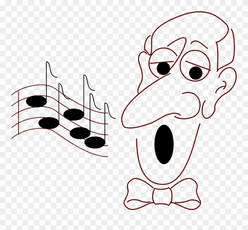“Head” voice is a term used to describe the type of voice that creates a ringing sensation in singer’s head, as opposed to the “chest” voice, which causes the vibrations to be felt mainly in the chest. The difference results from the alteration in the shape and the thickness of the vocal folds, specific to these two voices. Head voice should not be confused with falsetto, the highest register of the male voice. Falsetto is not used in classical singing; it may be used in humorous imitation of the female voice, and in certain range-extension drills. Head voice occurs over a series of pitches where the vocal folds are stretched and thin. This thinning is a result of the increased activity of the cricothyroid (CT) muscle (vocal fold lengthener) and decreased activity of the thyroarytenoid (TA), or vocalis muscle (vocal fold tightener), which is the muscular body of the vocal folds. Head voice is sometimes referred to as the “lighter mechanism” of the voice because there is less vocal fold mass involved in its production. Head voice is usually described as bright and ringing. The two muscle groups described above are used by classical singers to vary the pitch of the sound they produce. The singer can tighten/shorten the TA muscle, which raises the pitch; he can also stretch/thin the vocal folds by using the CT muscle, which does so by tilting the thyroid cartilage (the Adam’s apple). Trained singers use both these mechanisms, as well as the mix of the two, in order to access and acoustically equalise and smoothen their entire vocal range. For various reasons, including social habits, the male voice has a chest-dominant quality to its speaking voice, while the female voice has a head-dominant quality. It stands to reason that over the years, the dominant register of the two voices will be the one that is most developed. As a result, men seldom have a well-developed head voice without having specifically trained it. The consequence is a limited vocal range and no access to high notes. While the chest voice is resonant, warm and masculine, it can only take the singer up to his 1st passaggio, an important pivotal point in every voice where the switch from “chest” to “head” must begin. Baritones can find it hard to sing above C# or D, and tenors above E or F by using the chest voice only. If they continue to ascend in the chest mode beyond the 1st passaggio they will strain the voice, forcibly raise the larynx and turn the voice into a yell and eventually break into the comedic falsetto. Note that raising the larynx is an alternative (the third) pitch changing mechanism, and undesirable in elite classical singing. It is worth noting that many female singers, even operatic professionals, can sing their entire range in the head voice. However, while not needing the chest voice that much, sopranos would benefit from having a well-developed chest voice. While the “chest” may not be used directly by a female singer, having it gives depth and fullness to her head voice. In summary, female singers can live without the chest voice, while male singers must develop the head voice and use it in addition to their obligatory chest voice. When training male singers, the voice teacher must intervene to identify and develop the “unused” head register. Many young male singers attempt to sing classical repertoire using the only voice that they know, the chest voice. Their attempts result in a severely strained, uncontrolled, and spread sound as they ascend. Male singers must understand how to relax the TA muscle and activate the CT muscles of the larynx as they approach the pivotal point called the 1st passaggio, enabling the voice to “turn”. To some readers this change may be known as “covering” the voice. It is highly desirable that the head voice is demonstrated to the untrained singer, who may even be unaware of its existence. Many examples are available online. It does not take long to get the hang of the head voice, and it opens up a whole new world to a bass, baritone or tenor. There are several approaches to teaching the head voice, depending on how developed the voice is – existent but undeveloped, or the student has no access to it at all. Finding the Head Voice Without a vocal instructor, finding the head voice requires some vocal exploration. Here are a few ideas. · For those males who have no access to it the first step is usually to learn to speak in head voice, imitating storytelling speech practiced by storytellers that use head voice for young characters in the story. · Yawn sighs are the next step between speaking in head voice and singing in it: slur from the very top of the vocal range to the bottom and keep the voice light and airy. · Next, try an exaggerated, voiced sigh. Slide as slowly as possible, noting all the variations in the voice. Men have a natural break between their falsetto (highest notes) and head voice (next highest). The next step is to sing in head voice. · Start with a yawn sigh and stop somewhere in the top of the voice and hold the note. If volume is added, the singer should suddenly find himself singing in the head voice. At first the brighter vocal sound may not be favourite to a male singer, but he will soon realise that it leads to greater vocal freedom as the singer learn to mix in the warmer sound of chest voice. · Sing “miaouw” in comfortable vocal range. The combination of vowels with encourage a high larynx position; while a high larynx is not a goal itself in classical singing, it facilitates finding the head voice.  ·
2 Comments
 As I mentioned last week, I think that both poetry and music can have a great effect on our moods. In fact I believe that music has an even greater effect on our moods than poetry, partly because much of it – and certainly the music that I enjoy most – is made by lots of people working together. I think that if I had to choose eight discs to take to a desert island (I still think of pieces of music on discs – “Desert Island mp3s” doesn’t have quite the same alliterative ring to it!) many of the pieces of music would be from 100 years ago and further back. That’s not because I don’t like modern music – I do – but because most pieces of music written these days are short and generally focused on one emotion – love, longing, anger, hope – so to get all those emotions in popular music written since the 1960s I would have to choose four “discs”. However, if I were to choose “Messiah” (just to take one example of an older work) I would have all those emotions and more on one “disc”. I don’t want this note to be longer than about 10 pages (I’ll bet some of you just skipped to the bottom to see if it IS that long! :-)) so I am only going to write about music that helps me to feel better if I’m fed up. I won’t include music that might be helpful in other stressful situations – for example, if I had a job interview coming up, or if I had a difficult decision to make; if I were ill or if I needed to focus for the day ahead – though of course some of the music I listen to if I’m fed up can also be helpful in these situations.  Dear Friends This is the first in a series of three or four linked contributions to the blog from Johnny and me. In this first one, I have written about how poetry helps me feel better. In the next two Johnny and I will write about music. As you read, you may like to think about music that helps you feel better, and please do share that with us if you can. Problems can make you feel lonely, but sharing ideas helps us to feel connected again. Your ideas and suggestions will be drawn together into the fourth (and maybe fifth and sixth) contribution to this blog. Or, of course, you could just write a contribution to the blog yourself :-) Either way, please do tell us all about music and poetry that helps you at difficult times! Best wishes, Tim A few years ago I was given a delightful book – “The Poetry Pharmacy”. The author suggested that poetry is a powerful mood influencer and that it can (for example) help us to feel calmer if we are frustrated, happier if we are sad, and more determined if we are unsure. I really liked this idea, as it reflected my own experience, both with poetry and with music. I mentioned this idea to Johnny a little while ago and he suggested that we write this blog. Please do share your ideas…..are there special “go to” poems or pieces of music that really help you? Tone Onset – The Germ of Good Vocalism |
It's good to share!Got something you'd like to share with us all? Perhaps some interesting research, an event or experience or some other art, media or enterprise that you'd like to contribute. Archives
May 2021
Categories |




 RSS Feed
RSS Feed